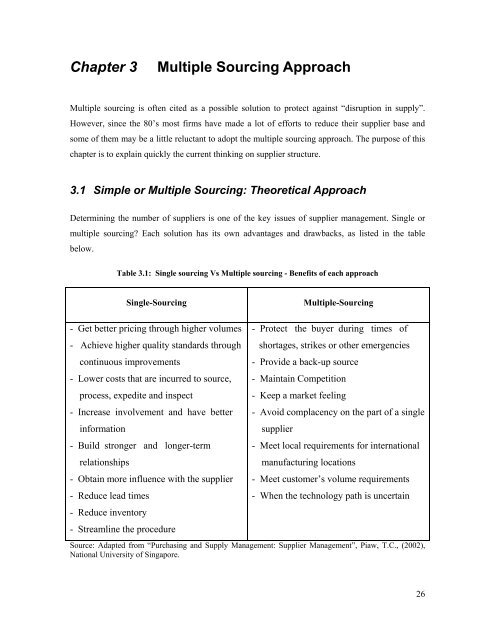Managing Risks of Supply-Chain Disruptions: Dual ... - CiteSeerX
Managing Risks of Supply-Chain Disruptions: Dual ... - CiteSeerX
Managing Risks of Supply-Chain Disruptions: Dual ... - CiteSeerX
Create successful ePaper yourself
Turn your PDF publications into a flip-book with our unique Google optimized e-Paper software.
Chapter 3Multiple Sourcing ApproachMultiple sourcing is <strong>of</strong>ten cited as a possible solution to protect against “disruption in supply”.However, since the 80’s most firms have made a lot <strong>of</strong> efforts to reduce their supplier base andsome <strong>of</strong> them may be a little reluctant to adopt the multiple sourcing approach. The purpose <strong>of</strong> thischapter is to explain quickly the current thinking on supplier structure.3.1 Simple or Multiple Sourcing: Theoretical ApproachDetermining the number <strong>of</strong> suppliers is one <strong>of</strong> the key issues <strong>of</strong> supplier management. Single ormultiple sourcing? Each solution has its own advantages and drawbacks, as listed in the tablebelow.Table 3.1: Single sourcing Vs Multiple sourcing - Benefits <strong>of</strong> each approachSingle-SourcingMultiple-Sourcing- Get better pricing through higher volumes- Achieve higher quality standards throughcontinuous improvements- Lower costs that are incurred to source,process, expedite and inspect- Increase involvement and have betterinformation- Build stronger and longer-termrelationships- Obtain more influence with the supplier- Reduce lead times- Reduce inventory- Streamline the procedure- Protect the buyer during times <strong>of</strong>shortages, strikes or other emergencies- Provide a back-up source- Maintain Competition- Keep a market feeling- Avoid complacency on the part <strong>of</strong> a singlesupplier- Meet local requirements for internationalmanufacturing locations- Meet customer’s volume requirements- When the technology path is uncertainSource: Adapted from “Purchasing and <strong>Supply</strong> Management: Supplier Management”, Piaw, T.C., (2002),National University <strong>of</strong> Singapore.26
















